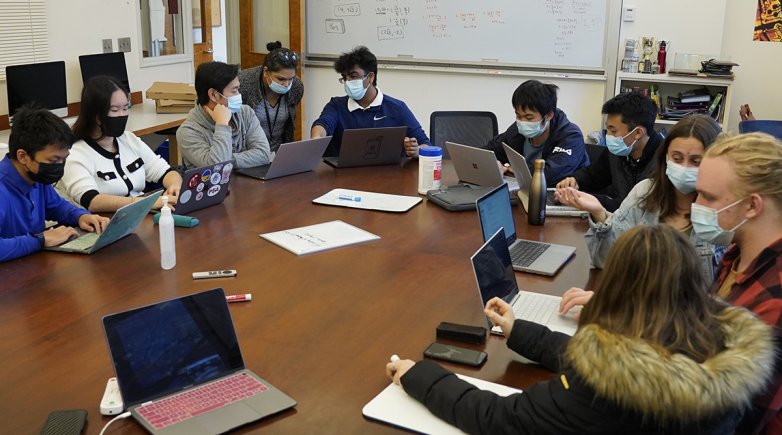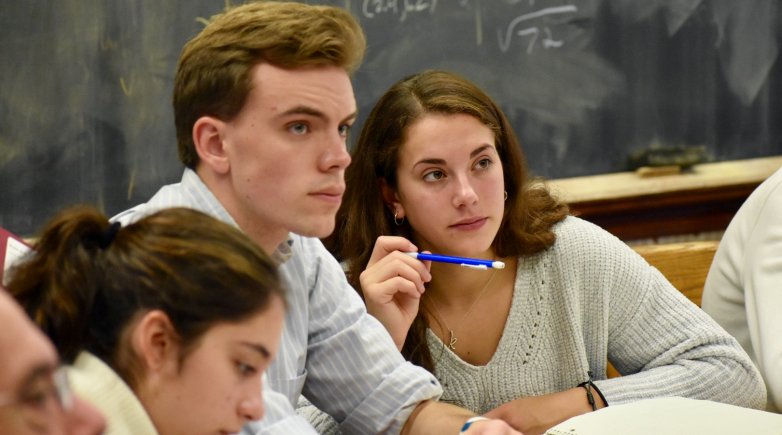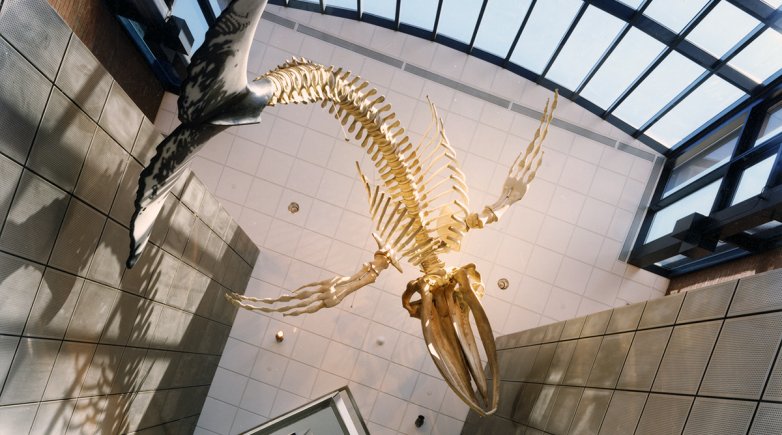Unlocking the code
Computer Science learning at Exeter.
On a Friday afternoon in November, Davido Zhang ’25 and Clark Wu ’23 huddle around their open laptops in the Phelps Science Center discussing ... cats. They are deep into the task, perfecting code for a game they’ve created called “Catguessr.” It’s their final project for CSC590: Selected Topics in Computer Science, which this term focuses on database development. The game rewards players for identifying up to 70 breeds of cats. Classifying an American shorthair maybe simple for a cat lover, but developing the game’s backend hasn’t been easy. Zhang, Wu and their classmates have had to master four web programming languages —HTML, CSS, JavaScript and SQL — to specifically manage the data and databases they’ve created for their projects. “The students have to know what a website looks like, what would make it more attractive to people looking at it, then how to make it interactive,” Computer Science Instructor Ranila Haider says.
CSC590 is Exeter’s highest-level computer science course, and one of seven courses offered as part of the Academy’s wide-ranging curriculum. Based on algorithmic thinking, the curriculum is unique in its focus on hands-on learning and emphasis on Harkness-style understanding of technology and its societal impact. The goal is not only to inspire students to explore their passion for writing code or designing mobile apps, but also to help students recognize the relationships between computer science and other disciplines, such as physics or the humanities, and encourage them to study further.
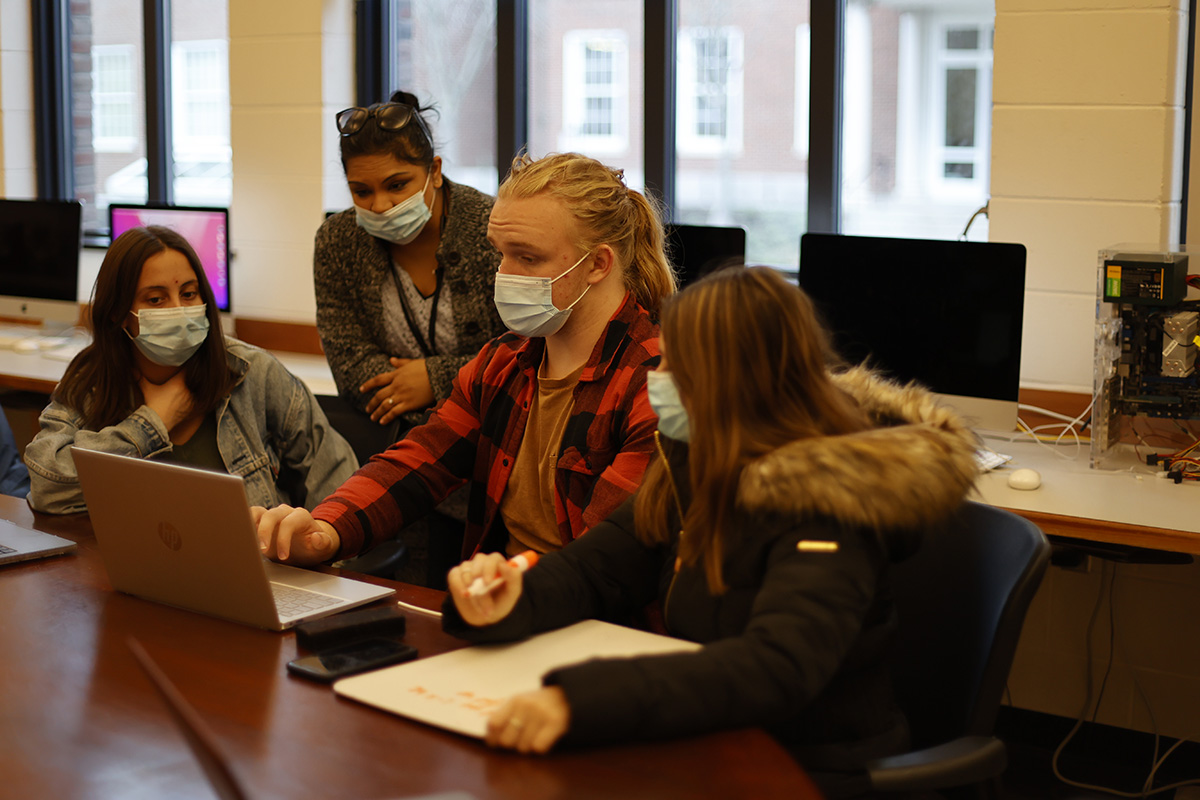
“Our courses create a pathway for students who don’t consider themselves ‘computer science people,’” says Sean Campbell, Alfred H. Hayes ’25 and Jean M. Hayes Teaching Chair in Science and instructor in Computer Science. Director of Studies Scott Saltman agrees. “Before the graduation requirement was put in place, there were kids who didn’t take computer science or just took one course,” he says. “Now mid- and upper-level courses are attracting students into the program.”
A brief history of computer science
Computer science has been a part of campus learning since the 1960s, when the Academy first subscribed to Dartmouth College’s time-sharing computer system. Through this pioneering arrangement, faculty and students in Exeter accessed Dartmouth’s giant mainframe in Hanover, New Hampshire, through a General Electric-235 computer and teletype, a typewriter-style keyboard, housed on the first floor of the Academy Building. Information processed at Dartmouth was printed on spools of paper in Exeter. Students and teachers used the system to write programs in BASIC (Beginners All-Purpose Symbolic Instruction Code) —a computer language created by John G. Kemeny and Thomas E. Kurtz at Dartmouth College in 1964 — to solve math problems, but playing games like tic-tac-toe, roulette, golf, baseball and bingo were equally popular. According to The Exonian, more than 100 people used the GE-235 in 1966. The Exeter Computing Club was founded the same year, heralding a new passion for exploring computer languages on campus.
There was so much interest in burgeoning computer technology that discussions began about adding courses to the curriculum. In 1968, the math faculty recommended a two-week noncredit course in writing BASIC. Four years later, the Curriculum Committee recommended adding an interdisciplinary course for preps, teaching computer techniques alongside “skills of observation, selection, arrangement of data, generalization from evidence and communication of results.” The first dedicated computer science course, an advanced placement course focused on learning the PASCAL language, was officially added to the curriculum in 1983. The course “marks the acceptance of the personal computer as the indispensable education and communications tool of our time,” Principal Stephen Kurtz wrote in the fall 1983 issue of The Exeter Bulletin.
The same year, an interdisciplinary committee developed guidelines for future computer science courses and called for making personal computers available to each student and instructor. Exeter also led the way in instructor training when it started a mathematics and computer conference for secondary school teachers in the early 1980s. Now called the Anja S. Greer Conference on Mathematics and Technology, it’s the school’s longest-running teacher conference.
Navigating change
Change does not come without challenges. Students and faculty with computer expertise were recruited to shepherd Exeter through its early transition to the new technology. Cedric Antosiewicz ’79 was part of a small group of Exonians charged with helping maintain the school’s computers while he was a student. He returned to campus in 1983 to teach a weeklong summer class about PASCAL to math, science, English and classics faculty. Math Instructor Bill Campbell taught interested faculty, staff and spouses a course on BASIC. Math Instructor Eric Bergofsky, an early school computer coordinator, recruited students from his classes as well as the Computer Club to help him maintain Exeter’s state-of-the-art Digital Equipment Corporation PDP-11/44 time-sharing mainframe (it had 256K of internal memory and two disk drives). Located in Room 103 of the Academy Building, next to a classroom that contained teletypes hard-wired into the mainframe, it had to be backed up daily onto large circular disks “that held less memory than an average cellphone,” Bergofsky says. “We had to learn the Digital Equipment Corporation language to administer the machine, check the manual when there was a problem or call Digital Equipment if we had questions.”
Peter Durham ’85 was among the students working alongside Bergofsky to help manage the computer room. He was one of the few students who arrived at Exeter with his own personal computer, a TRS-80 color desktop “microcomputer” from Tandy Radio Shack that he happily shared with classmates. “It was plugged into a TV,” Durham says. “I had to get special permission to have a television on campus.” He says he developed his knack for teaching at Exeter, where he held workshops for students and faculty on the C and PDP-11 assembler languages.
Hard-wired for success
Durham became the chief software architect of the technology that powered MSNBC.com and later NBC News Digital. In true non sibi spirit, he’s now a senior software engineer developing programs that power Microsoft’s Accessibility Insights, open-source tools helping make computers and the internet more accessible to people with disabilities.
In 1996, each dorm was wired for internet access and each dorm room was wired for a landline telephone. As Exeter became “hard-wired” for success, a support system was needed. Academic Technology Coordinator Vi Richter, who joined the Math Department that year to teach classes in applications like Microsoft Word and Excel, became the school’s first dedicated computer support desk person. “I was on the phone eight hours a day, fielding questions,” she says.
Christine Robson Weaver ’99 was one of two female students recruited to troubleshoot tech issues in girls dorms as each came online. “We called ourselves ‘The Technical Ethernet Crisis Helpers,’” says Weaver, a former Bancroft Hall resident. “Any time there was a problem after a dorm went online, we checked it out. My dorm and one boys dorm were the first to come online, and we had an instant connection because we knew we could phone or email each other.”
In an era of Hotmail accounts and accessing the web via CD downloads of America Online (AOL) software, the campus was changing. “Everyone was excited about the potential of the internet,” Weaver says. “A lot of students became quite tech-savvy and came from families who may not have had computers or internet access. It was a big step forward.”
After receiving undergraduate and graduate degrees from MIT in mathematics and computer science and a Ph.D. in computer science from the University of California, Berkeley, Weaver started her career at IBM, doing predictive modeling and machine learning. She joined Google in 2012 as the company’s first product lead for machine learning. Now Weaver is involved in diversity, equity and inclusion efforts at Google and draws on her Exeter experiences to maintain connections. She returns to campus often as a mentor and speaker, and founded an Exeter alumni employee group at Google. “At Exeter, I was surrounded by bright kids who were nothing like me, but we all loved to learn,” she says. “That common sense of belonging was magic.”
20th-Century learning
The dot-com boom of the late 1990s popularized personal computing and computer science as an academic discipline. When the Phelps Science Center opened in 2001, computer science classes were relocated from the Academy Building to a designated space in Phelps. The move was both practical and symbolic. Three years later, the Curriculum Review Committee approved a course on algorithmic thinking as a diploma requirement for all four-year students, further legitimizing computer science as valuable coursework and making Exeter one of the first prep schools to require computer science for graduation. Instructor Matt Brenner recommended the course, believing that understanding computers would help students fully understand contemporary social issues; the new course was first offered during the 2005-06 school year.
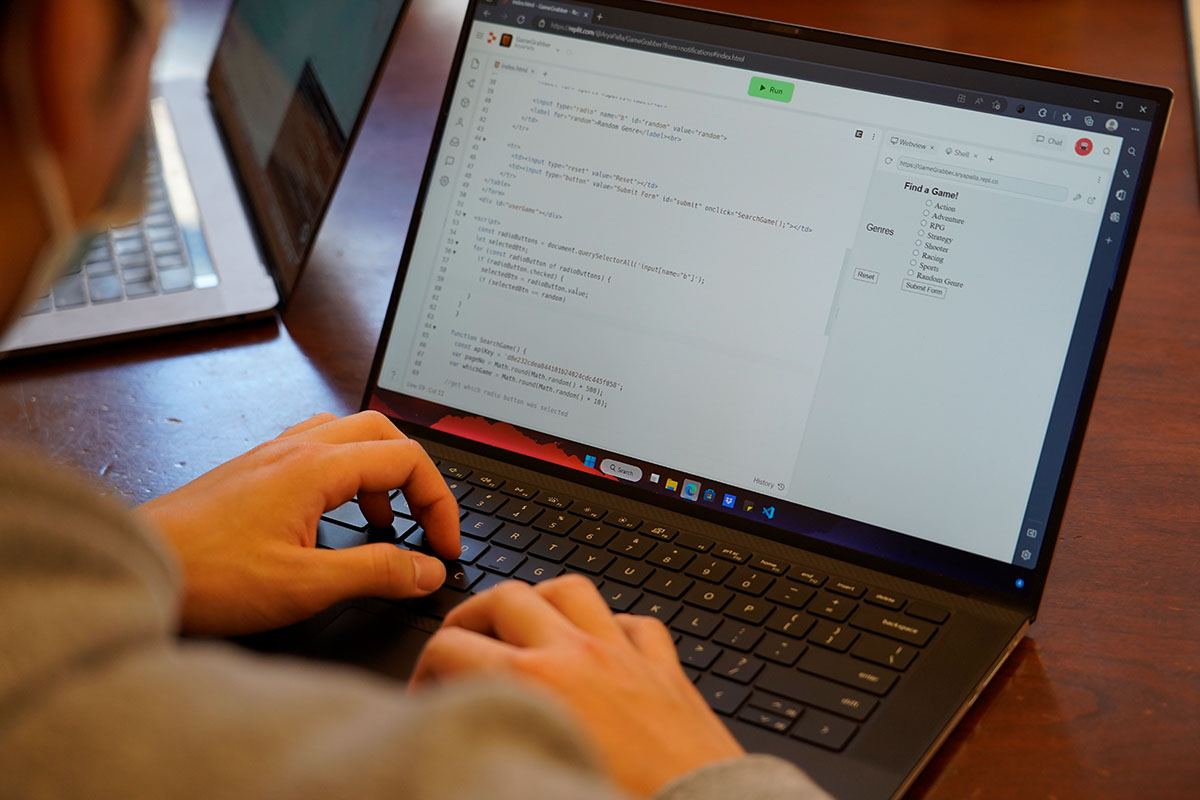
As computer science has evolved over the last 20 years, so, too, has Exeter’s curriculum. Now led by three full-time computer science instructors teaching more than 30 sections of computer science a year, the program combines practical learning with less structured room to explore (course content forCSC590, for example, is suggested by former students, and the class can be taken more than once). “We have a lot of hands-on learning,” Sean Campbell says. “People don’t perceive computer science as a creative act, but students are creating and they bring all kinds of other interests, connections and abilities to their projects. It’s cool to see what they come up with.
Editor's note: This article first appeared in the winter 2023 issue of The Exeter Bulletin.
